
Wine Culture and Information since 2002 - Volume 22
 Wine Culture and Information since 2002 - Volume 22 |
|
Comparing Tocai FriulanoThe magnificent grape of Friuli Venezia Giulia is famous for its strong almond aroma and it is capable of producing full bodied and elegant white wines |
|
In the last years there have been a lot of talking about Tocai Friulano, the great white berried grape of Friuli Venezia Giulia, unfortunately not for its enological qualities, but for a dispute which have seen it as the protagonist of a dispute in the European Court. The dispute is certainly known to everyone interested in wine, as well as it is known the verdict which have seen the defeat of Tocai Friulano, in the name only, of course. In fact, as of March 31st, 2007, our grape cannot be called with this name anymore - and among the most hypothesis about the new name, Friulano seems to be the most probable - as the term Tocai has been exclusively recognized to Hungary for the identification of its famous wines. Despite the recent events which would put a shadow on the good name of Tocai Friulano, the great grape from Friuli Venezia Giulia will continue - there is no doubt about this - to make extraordinary wines like we are used to see since many years. Tocai Friulano - whose presence in the territory of Friuli Venezia Giulia is proven for more than 800 years - has faced alternated moments of notoriety and quality, sharing the same fate, in this aspect, with many other Italian grapes. Up to about twenty years ago, Tocai Friulano was in fact widely used for the production of countless table wines of non truly amazing quality. Coarse wines, with deep colors and ordinary taste, was everything the production of those times was capable of offering consumers with Tocai Friulano, in those times in which it was quantity to set the rules in wineries instead of quality. When in Italy it was finally understood the success would have been necessarily passed for the strict path of quality, Tocai Friulano began to surprise consumers for its remarkable wines and today it is fully considered one of the greatest white berried grapes of Italy.
|
|
Tocai Friulano is mainly cultivated in Friuli Venezia Giulia, although there are some vineyards present in Veneto, Lombardy and Emilia Romagna as well. In its homeland, Tocai Friulano is common all over the territory and it is used alone for the production of white wines belonging to the many areas recognized as Denominazione d'Origine Controllata (DOC) of Friuli Venezia Giulia. Tocai Friulano is also used - together with other autochthonous and international grapes - for the production of Indicazione Geografica Tipica (IGT) wines. The goal of our comparative tasting is to highlight the main organoleptic qualities of this grape, including the characteristic almond aroma that, despite it is frequent in other white berried grapes as well, in Tocai Friulano it is pretty strong. The most common vinification technique makes use of the fermentation and aging in inert containers - steel and cement - however some producers also use cask, therefore giving the wine more complex aromatic qualities although keeping the peculiarities of Tocai Friulano.
The three wines of our comparative tasting are from three classic areas of Friuli Venezia Giulia, also famous for other wines besides Tocai Friulano. The first wine of our comparative tasting is Scubla's Colli Orientali del Friuli Tocai Friulano, aged for 8 months in steel tanks. The second wine is La Boatina's Collio Tocai Friulano, a wine from the largest Denominazione d'Origine Controllata area of Friuli Venezia Giulia, aged in steel tanks. The third wine is Borgo San Daniele's Friuli Isonzo Tocai Friulano, also in this case, aged in steel tanks. It should be noticed all the three wines have been aged in steel tanks, therefore it will be possible to fully appreciate the expression of Tocai Friulano without any influence from wood. The vintages of the tasting will belong to the latest ones and the temperature at which they will be tasted is of 11° C (51° F), in order to allow a proper expression of the aromas and gustatory qualities. As always, the tasting will de done by using three ISO tasting glasses.
|
||||||||
|
Tocai Friulano is a grape that in many cases produces wines with intense straw yellow color, or however with deeper and more intense hues as opposed to many other white grapes, such as Sauvignon Blanc, whose wines usually show a greenish yellow color. This characteristic was well evident in the past, when the color of Tocai Friulano wines showed intense straw yellow colors as well as golden yellow, even in youth. With the improving of vinification techniques and the adoption of cold maceration, the color of modern Tocai Friulano is evidently paler - it can happen to see even greenish yellow nuances - however the color is most of the times straw yellow with different hues and intensities. Tocai Friulano, thanks to its quality, can also be aged for some years in bottle. In this specific case the evolution of the color will be characterized by straw yellow hues with increasing intensity that with time will become golden yellow. The first wine we will examine is Scubla's Colli Orientali del Friuli Tocai Friulano. By holding the glass tilted over a white surface, at the base it will be observed a pretty intense and bright greenish yellow color, and to the edge of the liquid mass - towards the opening of the glass - it will be observed nuances of the same color. The second wine of which we will evaluate appearance is La Boatina's Collio Tocai Friulano. By observing the wine at the base of the glass - held titled over a white surface - it will be noticed, just like the previous wine, an intense greenish yellow color and to the edge, towards the opening of the glass, nuances of the same color. The last wine that we will examine is Borgo San Daniele's Friuli Isonzo Tocai Friulano. At the base of the glass will be observed a deeper and more intense color than the previous ones, here the color is intense straw yellow, however, by observing the edge of the liquid mass, it will be noticed greenish yellow nuances, just like the previous wines.
|
|
The olfactory qualities of Tocai Friulano are pretty vast, however the wines produced with this grape will be characterized by strong almond aroma - frequently bitter almond - and despite this is not an exclusive aromatic quality of Tocai Friulano, this aroma will be the signal of its possible presence in our glass. Tocai Friulano is also characterized by aromas of fruits - apple, pear and plum, and frequently peach - as well as flowers, in particular field flowers, hawthorn, broom, chamomile and, sometimes, hints of acacia. With time, Tocai Friulano tends to develop a particular aroma of honey, as well as of ripe fruits. In Tocai Friulano are also found aromas of tropical fruits, in particular pineapple, grapefruit and - sometimes - banana. In case Tocai Friulano has been harvested unripe, or in vintages characterized by cold meteorological conditions, it can tend to develop aromas of vegetable and herbs, such as hay, nettle and walnut husk. Aromatic herbs can also be present in Tocai Friulano wines, in particular thyme and rosemary. The first wine we will examine is Scubla's Colli Orientali del Friuli. By holding the glass in vertical position and without moving it, we will do a first smell in order to evaluate opening aromas. It will be perceived aromas of pear, peach, hawthorn and - despite it is less evident than the other ones - the typical aroma of almond. After having swirled the glass, it will be done a second smell that will allow the perception of aromas of broom, field flowers and hints of tropical fruits, such as litchi and pineapple. We will now examine La Boatina's Collio Tocai Friulano, aged, like the other wines, in steel tanks. By holding the glass in vertical position, it will be done the evaluation of opening aromas. After the first smell, it will be perceived aromas of pear, peach and the typical aroma of almond: a pretty similar opening to Scubla's Tocai Friulano, even though in this case, the aroma of almond is more evident. After having swirled the glass, in order to favor a proper oxygenation of the wine, we will proceed with a second smell. The aromatic sequence of La Boatina's Tocai Friulano will be completed by aromas of hawthorn, broom, lemon and pineapple, as well as hints of mineral and elder aromas. We will now evaluate the aromas of the third wine: Borgo San Daniele's Friuli Isonzo Tocai Friulano. The opening aromas will offer the typical hint of almond and aromas of plum and hawthorn. After having swirled the glass, we will proceed with a second smell which will allow the perception of apple, grapefruit and - just like in the previous wine - hints of mineral. As opposed to the previous wines, in this Tocai Friulano will be perceived an evident aroma of yeast, a sign the wine has been aged for some months in its lees, therefore giving more complex and rich aromas to this Tocai Friulano. Despite the three wines are from three different areas, although all belonging to Friuli Venezia Giulia, it is interesting to notice the different intensities of the almond aroma, typical in Tocai Friulano.
|
||||
|
Tocai Friulano is not a grape producing light wines or with a weak body. This was in fact one of the qualities for which the grape was appreciated by those producers who saw in quantity their only enological goal. Wines produced with Tocai Friulano are in fact characterized by a good structure as well as their typical crispness - giving a pleasing freshness to wine - including pretty high alcohol by volume, sometimes reaching 14%. When used alone, the taste of Tocai Friulano is pretty dry and crisp, its structure is well perceived from the first sip, in other words, it is not a wine which remains unnoticed. These qualities make this grape very useful for giving more body to other wines produced with lighter grapes: the presence of Tocai Friulano, also in this case, is not unnoticed. Just like for aromas, also in the taste the flavor of almond is pretty evident, in particular in the aromas left in the mouth after having swallowed the wine. The first wine of which we will examine taste is Scubla's Colli Orientali del Friuli Tocai Friulano. The attack of this wine - which can be evaluated at the first sip - is pretty crisp, characterized by a good acidity. It will also be noticed the good structure of the wine, which certainly is not light, if compared with other whites. Also the correspondence to the nose is very good and the wine is agreeable. The second wine we will examine is La Boatina's Collio Tocai Friulano. The attack of this wine is characterized by a good acidity, also in this case it will be noticed a good structure and the right contribution of alcohol in the balance of the wine. The last wine to be examined is Borgo San Daniele's Friuli Isonzo Tocai Friulano. The attack of this Tocai is characterized by a pleasing acidity, however, as opposed to the other wines, it will be noticed a higher structure and smoothness, two factors that will make the wine seem less acid. Also in this case, it will be noticed how the contribution of alcohol is fundamental for the balance of the wine.
|
|
The organoleptic characteristics of Tocai Friulano will be evident in the final phase of the comparative tasting, after having swallowed the wine and it will evaluated the taste-olfactory persistence. Scubla's Colli Orientali del Friuli Tocai Friulano is persistent and characterized by flavors of pear, peach, apple and almond. Also the finish of La Boatina's Collio Tocai Friulano will be persistent with flavors of peach, pear, pineapple and, also in this case, almond. The finish of the third wine, Borgo San Daniele's Friuli Isonzo Tocai Friulano, is persistent with flavors of plum, pear and almond. It should be noticed that in the finish of all the three wines can be perceived the flavor of almond, although with different intensities, a quality typical in Tocai Friulano. The acidity of the three wines will also be a well perceptible quality in the final phase of the tasting. Tocai Friulano is a grape capable of making great wines, in which it is possible to perceive its typical qualities even in case it is being used with other varieties.
|
Wines of the Month |
|
|
|
Score legend Prices are to be considered as indicative. Prices may vary according to the country or the shop where wines are bought |
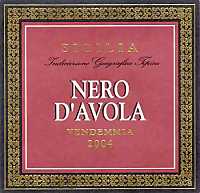
|
|
Nero d'Avola 2004 |
|
| Morgante (Sicily, Italy) | |
| Grapes: Nero d'Avola | |
| Price: € 6.50 | Score: |
| The wine shows an intense ruby red color and nuances of ruby red, moderate transparency. The nose denotes intense, clean and pleasing aromas which start with hints of black cherry and plum followed by aromas of blueberry, vanilla, cyclamen and carob. The mouth has good correspondence to the nose, a slightly tannic attack and however balanced by alcohol, good body, intense flavors. The finish is persistent with flavors of plum and black cherry. This Nero d'Avola ages for 4 months in barrique. | |
| Food Match: Roasted meat, Braised and stewed meat | |
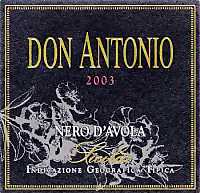
|
|
Don Antonio 2003 |
|
| Morgante (Sicily, Italy) | |
| Grapes: Nero d'Avola | |
| Price: € 20.00 | Score: |
| The wine shows an intense ruby red color and nuances of garnet red, little transparency. The nose reveals intense, clean, pleasing, refined and elegant aromas which start with hints of plum, blackberry and black cherry followed by aromas of blueberry, violet, vanilla, carob, cyclamen, licorice, tobacco and pink pepper. The mouth has good correspondence to the nose, a tannic attack and however balanced by alcohol, full body, intense flavors, agreeable. The finish is persistent with flavors of blackberry and plum. A well made wine. Don Antonio ages for 12 months in barrique followed by 7-8 months of aging in bottle. | |
| Food Match: Game, Roasted meat, Braised and stewed meat, Hard cheese | |
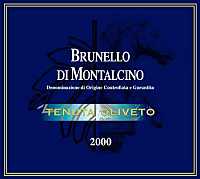
|
|
Brunello di Montalcino 2000 |
|
| Tenuta Oliveto (Tuscany, Italy) | |
| Grapes: Sangiovese Grosso | |
| Price: € 38.00 | Score: |
| This Brunello di Montalcino shows an intense ruby red color and nuances of garnet red, little transparency. The nose reveals intense, clean, pleasing, refined and elegant aromas which start with hints of plum, blackberry and black cherry followed by aromas of blueberry, violet, vanilla, tobacco, cinnamon, licorice, cocoa, pink pepper and eucalyptus. The mouth has good correspondence to the nose, a tannic attack and however balanced by alcohol, full body, intense flavors, agreeable. The finish is persistent with flavors of black cherry, blackberry and plum. A well made wine. This Brunello di Montalcino ages for 30 months in cask followed by 30 months of aging in bottle. | |
| Food Match: Game, Braised and stewed meat, Roasted meat, Hard cheese | |
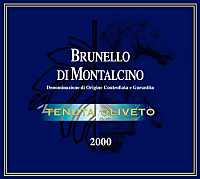
|
|
Brunello di Montalcino Riserva 1999 |
|
| Tenuta Oliveto (Tuscany, Italy) | |
| Grapes: Sangiovese Grosso | |
| Price: € 52.00 | Score: |
| This wine shows a brilliant ruby red color and nuances of garnet red, moderate transparency. The nose reveals intense, clean, pleasing, refined and elegant aromas which start with hints of prune, dried violet and black cherry jam followed by aromas of strawberry jam, raspberry jam, vanilla, tobacco, licorice, cocoa, cinnamon, leather and mace. The mouth has good correspondence to the nose, a tannic attack and pleasing roundness, however balanced by alcohol, full body, intense flavors. The finish is persistent with flavors of prune, black cherry jam and raspberry jam. A well made wine. This reserve of Brunello di Montalcino ages for 3 years in cask followed by 30 months of aging in bottle. | |
| Food Match: Game, Roasted meat, Braised and stewed meat, Hard cheese | |
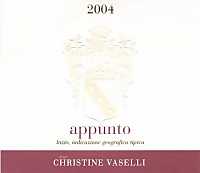
|
|
Appunto 2004 |
|
| Christine Vaselli (Latium, Italy) | |
| Grapes: Canaiolo Nero, Ciliegiolo | |
| Price: € 5.00 | Score: |
| This wine shows an intense ruby red color and nuances of ruby red, little transparency. The nose denotes intense, clean and pleasing aromas which start with hints of blackberry and raspberry followed by aromas of black cherry, strawberry, pomegranate, blueberry and violet. The mouth has good correspondence to the nose, a slightly tannic attack and pleasing crispness, however balanced by alcohol, good body, intense flavors. The finish is persistent with flavors of blackberry, black cherry and raspberry. This wine ages in steel tanks. | |
| Food Match: Cold cuts, Pasta with meat and mushrooms, Sauteed meat | |
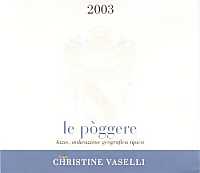
|
|
Le Poggere 2003 |
|
| Christine Vaselli (Latium, Italy) | |
| Grapes: Cabernet Sauvignon (70%), Merlot (30%) | |
| Price: € 18.00 | Score: |
| This wine shows a deep ruby red color and nuances of ruby red, little transparency. The nose denotes intense, clean, pleasing, refined and elegant aromas which start with hints of black cherry, plum and black currant followed by aromas of violet, vanilla, tobacco, cinnamon, chocolate, mace and eucalyptus. The mouth has good correspondence to the nose, a tannic attack and however balanced by alcohol, full body, intense flavors, agreeable smoothness. The finish is persistent with flavors of black cherry, plum and black currant. A well made wine. Le Poggere ages for 12 months in barrique. | |
| Food Match: Roasted meat, Braised and stewed meat, Hard cheese | |
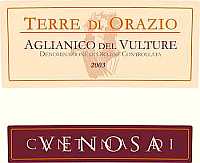
|
|
Aglianico del Vulture Terre di Orazio 2003 |
|
| Cantina di Venosa (Basilicata, Italy) | |
| Grapes: Aglianico | |
| Price: € 8.00 | Score: |
| This wine shows an intense ruby red color and nuances of garnet red, moderate transparency. The nose denotes intense, clean, pleasing and refined aromas that start with hints of black cherry, plum and violet followed by aromas of blueberry, blackberry, vanilla and cinnamon. The mouth has good correspondence to the nose, a tannic attack and however balanced by alcohol, good body, intense flavors. The finish is persistent with flavors of black cherry, plum and blueberry. This Aglianico del Vulture ages for about 15 months in cask followed by at least 6 months of aging in bottle. | |
| Food Match: Roasted meat, Stewed meat, Hard cheese | |
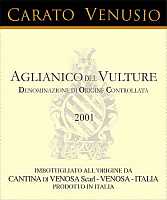
|
|
Aglianico del Vulture Carato Venusio 2001 |
|
| Cantina di Venosa (Basilicata, Italy) | |
| Grapes: Aglianico | |
| Price: € 15.00 | Score: |
| This Aglianico del Vulture shows a brilliant ruby red color and nuances of ruby red, little transparency. The nose denotes intense, clean, pleasing and refined aromas which start with hints of black cherry, plum and blackberry followed by aromas of blueberry, violet, vanilla, tobacco, pink pepper, carob and cinnamon. The mouth has good correspondence to the nose, a tannic attack and however balanced by alcohol, full body, intense flavors. The finish is persistent with flavors of black cherry, plum and blackberry. This wine ages for 12-18 months in barrique followed by at least 6 months of aging in bottle. | |
| Food Match: Roasted meat, Braised and stewed meat, Hard cheese | |
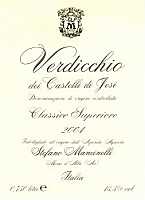
|
|
Verdicchio dei Castelli di Jesi Classico 2004 |
|
| Stefano Mancinelli (Marches, Italy) | |
| Grapes: Verdicchio | |
| Price: € 7.50 | Score: |
| The wine shows an intense greenish yellow color and nuances of straw yellow, very transparent. The nose reveals intense, clean and pleasing aromas that start with hints of hawthorn and apple followed by aromas of almond, pear, citrus fruits and plum. The mouth has good correspondence to the nose, a crisp attack and however balanced by alcohol, good body, pleasing roundness. The finish is persistent with flavors of apple, plum and almond. | |
| Food Match: Pasta with meat and mushrooms, Sauteed white meat, Broiled fish | |
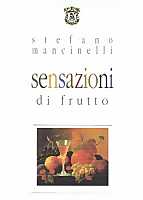
|
|
Lacrima di Morro d'Alba Sensazioni di Frutto 2005 |
|
| Stefano Mancinelli (Marches, Italy) | |
| Grapes: Lacrima di Morro d'Alba | |
| Price: € 10.00 | Score: |
| This wine shows a brilliant ruby red color and nuances of purple red, little transparency. The nose reveals intense, clean, pleasing and refined aromas which start with hints of strawberry, raspberry and blackberry followed by aromas of blueberry, black cherry, rose, violet, cyclamen and plum. The mouth has good correspondence to the nose, a slightly tannic attack and pleasing crispness, however balanced by alcohol, good body, intense flavors, agreeable. The finish is persistent with flavors of strawberry, raspberry and blackberry. This Lacrima di Morro d'Alba is produced with carbonic maceration and ages in steel tanks. | |
| Food Match: Pasta with meat and mushrooms, Sauteed meat with mushrooms | |
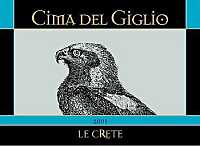
|
|
Colli Amerini Malvasia Cima del Giglio 2004 |
|
| Le Crete (Umbria, Italy) | |
| Grapes: Malvasia Bianca (90%), Trebbiano Toscano (5%), Verdello (5%) | |
| Price: € 7.00 | Score: |
| The wine shows an intense straw yellow color and nuances of straw yellow, very transparent. The nose denotes intense, clean, pleasing and refined aromas which start with hints of apple, pear and plum followed by aromas of hawthorn, hazelnut, litchi, praline, honey and vanilla. The mouth has good correspondence to the nose, a crisp attack and pleasing smoothness, however balanced by alcohol, good body, intense flavors. The finish is persistent with flavors of plum, apple and hazelnut. Cima del Giglio ages for 5-6 months in steel tanks. | |
| Food Match: Pasta and risotto with fish and vegetables, Broiled crustaceans and fish | |
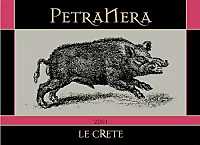
|
|
Colli Amerini Rosso Superiore Petranera 2003 |
|
| Le Crete (Umbria, Italy) | |
| Grapes: Sangiovese (70%), Merlot (10%), Barbera (10%) | |
| Price: € 9.00 | Score: |
| The wine shows a brilliant ruby red color and nuances of garnet red, moderate transparency. The nose denotes intense, clean, pleasing and refined aromas which start with hints of black cherry, violet and plum followed by aromas of blueberry, vanilla, carob and cinnamon. The mouth has good correspondence to the nose, a slightly tannic attack and pleasing roundness, however balanced by alcohol, intense flavors. The finish is persistent with flavors of black cherry, plum and blueberry. Petranera ages for about 6 months in barrique followed by at least 3 months of aging in bottle. | |
| Food Match: Roasted meat, Stewed meat with mushrooms, Hard cheese | |
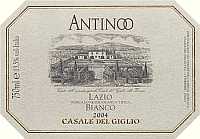
|
|
Antinoo 2004 |
|
| Casale del Giglio (Latium, Italy) | |
| Grapes: Chardonnay (66%), Viognier (34%) | |
| Price: € 9.00 | Score: |
| Antinoo shows a pale straw yellow color and nuances of greenish yellow, very transparent. The nose reveals intense, clean, pleasing and refined aromas which start with hints of apple, banana and toasted followed by aromas of pear, plum, grapefruit, vanilla, hazelnut, coffee, hawthorn and hints of mineral The mouth has good correspondence to the nose, a crisp attack and pleasing smoothness, however balanced by alcohol, good body, intense flavors, agreeable. The finish is persistent with flavors of banana, plum and grapefruit. Antinoo ages in barrique for 6-8 months followed by 6-12 months of aging in bottle. | |
| Food Match: Stuffed pasta with mushrooms, Roasted fish, Roasted white meat | |
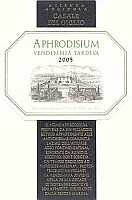
|
|
Aphrodisium 2005 |
|
| Casale del Giglio (Latium, Italy) | |
| Grapes: Viognier, Fiano, Greco Bianco, Petit Manseng | |
| Price: € 21.00 - 500ml | Score: |
| This wine shows a pale golden yellow color and nuances of golden yellow, very transparent. The nose reveals intense, clean, pleasing, refined and elegant aromas that start with hints of grape, apricot and peach followed by aromas of litchi, candied fruit, pear, vanilla, quince, date, almond and honey. The mouth has good correspondence to the nose, a sweet attack and pleasing crispness, however balanced by alcohol, good body, intense flavors, agreeable. The finish is persistent with flavors of grape, peach and honey. A well made wine. Aphrodisium ferments in barrique. | |
| Food Match: Fruit tarts, Hard cheese | |
|
||||||||
|
DiWineTaste Polls
|
| |||||||
Privacy Policy | |||||||


| Copyright © 2002-2024 Antonello Biancalana, DiWineTaste - All rights reserved |
| All rights reserved under international copyright conventions. No part of this publication and of this WEB site may be
reproduced or utilized in any form or by any means, electronic or mechanical, without permission in writing from DiWineTaste. |